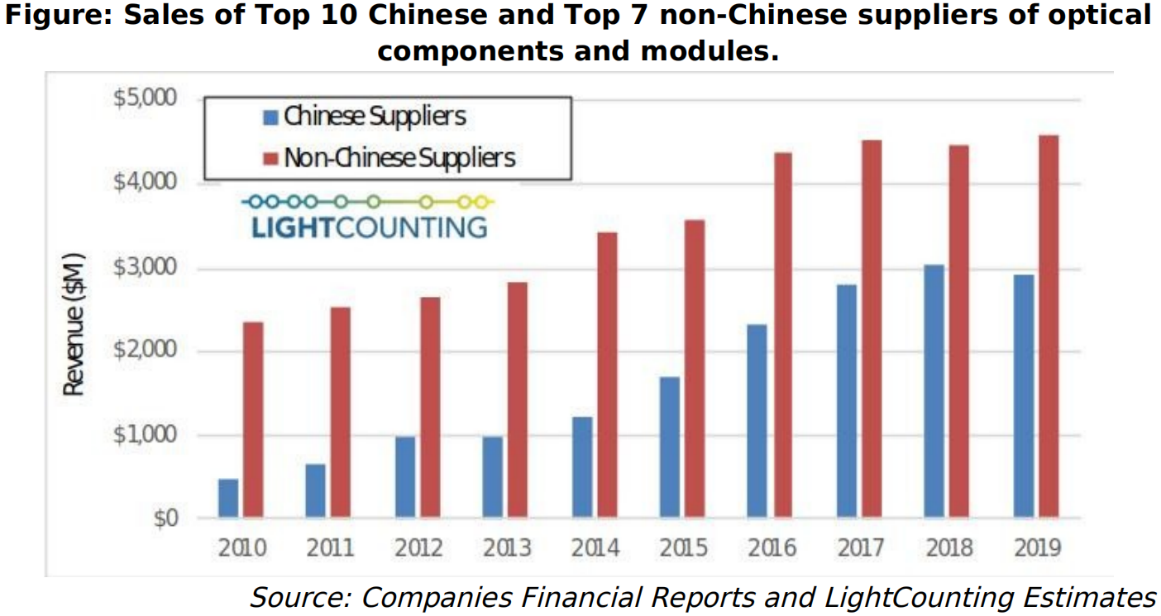Abstract: LightCounting (LC) believes that the decline in sales experienced by Chinese suppliers in 2019 had little to do with tariff increases. The decline is mainly because the sales of the leading supplier Innolight to major cloud companies failed to meet expectations; however, 2020 will present Innolight with a good opportunity to take the lead.
News from ICCSZ: LightCounting, a US optical component market analyst, reported that the optical component and optical module industry has provided a classic case study for globalization over the past 20 years, showing how globalization has rapidly changed the market in less than two decades. This all began with China's entry to the World Trade Organization (WTO) in 2001, after which western suppliers began rapidly migrating optical component manufacturing to China. After the telecom bubble burst, demand for optical products fell sharply from 2001 to 2003.At that time, many suppliers faced the struggle of a trade-off between price and market. Moving products to China became the optimal choice for suppliers to reduce costs and maintain profits.
As shown in the chart below, the sales of Chinese optical suppliers exceeded US$500 million by 2010. It then increased to US$3 billion by 2018, before slightly declining in 2019.
LC believes that the decline in sales in 2019 had little to do with tariff increases. The decline mainly occurred because the sales of the leading supplier Innolight to major cloud companies failed to meet expectations, because the purchase of high-speed Ethernet optical transceivers declined from late 2018 to early 2019.When the US government imposed a 15% tariff on Chinese-made optical transceivers in September 2019, Innolight’s sales to cloud customers began to pick up, indicating record-high sales in financial report in Q4.By January 2020, the tariff on optical transceivers dropped from 15% to 7.5%, which was completely offset by the devaluation of the renminbi.
Weak demand for high-speed Ethernet modules also hit US-based suppliers of high-speed Ethernet optical transceivers in 2019.However, driven by strong demand for wavelength selective switching (WSS), one of the few products that has not been mass produced by Chinese companies, overall sales from the top seven non-Chinese optical suppliers increased by 3% in 2019.At the same time, strong demand for pump lasers for optical amplifiers has helped II-VI Incorporated and Lumentum, the two largest non-Chinese suppliers, to maintain business growth from 2017 to 2019.
In addition to the recovery in demand for high-speed optical components, demand for 5G fronthaul optical components is also very strong in China. Innolight and several other Chinese suppliers expect to achieve record-high revenues in 2020 (Note: Innolight released its earnings pre-announcement for 2019 on the 23rd.).Western suppliers cannot ship 5G fronthaul transceivers to China (no tariff is needed to achieve this goal).The demand for WSS modules, amplifiers and pump lasers has begun to slow down, and Chinese suppliers are likely to account for over half of the total market in 2020 if this trend continues.
Finisar was the largest supplier of optical transceivers until 2018 and is likely to retain this position in 2019 (the company is now a part of II-VI Incorporated), but 2020 will present Innolight with a good opportunity to lead the market. If that happens, it will end Finisar’s domination and mean that five Chinese companies are in the global top ten. Among these, HG Genuine and Eoptolink will benefit from the demand for 5G fronthaul optical components. They expect to set new records in 2020 and enter the world’s top ten for the first time. Accelink and Hisense will also maintain their advantages. Huawei has started to produce more optical transceivers internally, and may reach the global top ten in the next year or two. Ciena, FiberHome, Infinera, and ZTE also plan to produce coherent dense wavelength division multiplexing (DWDM) modules in-house, which will lead to more fierce competition in a crowded market.
The fact that high-speed optics are the most important technology for switches, routers and transmission equipment is why these leading equipment manufacturers have started producing optical products in-house. However, commercial suppliers that offer high volumes of optical transceivers and other components at low cost will have a lot of flexibility to manage the situation. This is the right time for Chinese suppliers to lead the industry, and we will see more signs of that in 2020.
